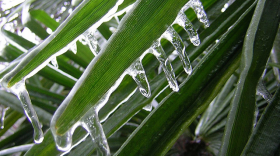In the Gulf of Mexico, seven and a half miles due west of Bonita Beach and 30 feet below the surface, grows an artificial reef and living classroom laboratory created by The Water School at Florida Gulf Coast University. This is the latest dispatch from Kimberly’s Reef.
Experiments on FGCUs Kimberly’s Reef include looking for red tide, gauging the temperature and chemical composition of the water, measuring the speed and direction of the currents in the Gulf of Mexico, and even counting the many fish attracted to the artificial structures.
Some of this research is often done by boat. However, for many scientists, like FGCU professor Melissa May, the best way to study the reef is below the surface.
"Kimberly's Reef was designed specifically to be a living research lab that we could go out to and scuba dive on and collect data and use it continuously. And so the purpose and design of the reef was for research," she said.

But before anyone dons scuba equipment for their research, they first must take part in the FGCU scientific diving program led by Calli Johnson.
"The scientific diving course is named that," said Johnson."But it's a bit of a misnomer because we really have to work on the safety part first, getting people underwater who may not have been underwater in a while, making sure that they're conducting dives safely so then we can focus on the science."
Johnson teaches the diving certification standards from the American Academy of Underwater Sciences.
"The scientific diving program here at school is designed to train our students as well as our faculty to conduct safe science underwater. And that looks multifaceted sometimes," said Johnson. "But a huge part of that program is getting our students into the water here at the Aquatic Center and then taking them diving off shore in different parts of Florida."
Adam Catasus, coordinator of the education and research for FGCU’s Vester Marine and Environmental Field Station, says the diving program is crucial for science students.
"A lot of students that help me are all graduates of that course," he said. "Those students, take the course, they get comfortable in the water, they get used to being in different scenarios like you're not always going to be. It's not always going to be flat. It's not always going to be crystal clear blue water."

He said it was important for students to get used to not being in the best underwater conditions because the job, whether it's sampling the water or counting fish, still has to be done.
To get students comfortable, Johnson takes her students to area lakes and mining pits to challenge them in low visibility water. It is especially important, she said, because some of the dive sites offshore in southwest Florida can be quite low visibility.

"We go to a place called Hudson Grotto, which is a tannic sinkhole. So it's dark," she said. "And that adds challenges to any activity that you're doing underwater."
Its often the first time her students have been in water where it seems as "if the sun was shut off."
Johnson said the reward for completing a dive successfully at the grotto can mean empowerment. Then comes the research skills.
"Then we build on those techniques to add specific scientific techniques that our researchers are required to do to conduct their investigations underwater," she said.
Then, students are able to assist on research projects. One specific example is helping create and attach sediment traps to the reef.

"It's a PVC device," she described. "It looks like it came from Home Depot because it did."
The device is attached to either the bottom or some other artificial surface and meant to hover in the water column to capture debris.
"One of our researchers who is interested in harmful algal blooms is trying to catch red tide in it," she said. "And so that is one of the research objectives that the students might have the opportunity to participate in after they graduate successfully from this course."
Other projects include identifying fish on Kimberly's Reef. That's what Kenzie Pruitt is doing as a Research Assistant at the Water School.

"My ultimate goal is to create a field guide for future research assistants, future students who are working on this project to allow them easier identification of the fish, as well as teach them how to determine certain metrics," said Pruitt.
FGCU Senior Macy Noll has combined her love of marine science, art and scientific diving by creating ceramic art to place on the reef.
"I really wanted to be in on the action and to get to not only be the one creating the sculptures that would be going on the reef, but be the one installing them and monitoring them and conducting research using those sculptures," said Noll. "So certification as a scientific diver was very important in order to be able to do that."

Noll waxes poetic about other benefits she's gleaned from her scientific diving course, and just being under water.
"I feel like coral reefs are these underwater cathedrals that are holy places almost, and they're so full of beauty, and it's such a treasure to be able to witness that."

Calli Johnson sees that joy extend a little further.
"There is an automatic joy once your head goes below the surface, and I think that's true for so many people," she said. "Then, I love bringing that joy and sharing that with our students here at FGCU."
Dispatches from Kimberly's Reef are part of a WGCU documentary project about the reef due out in 2025. The Kimberly's Reef documentary project is generously and partially funded by Bodil and George Gellman.







